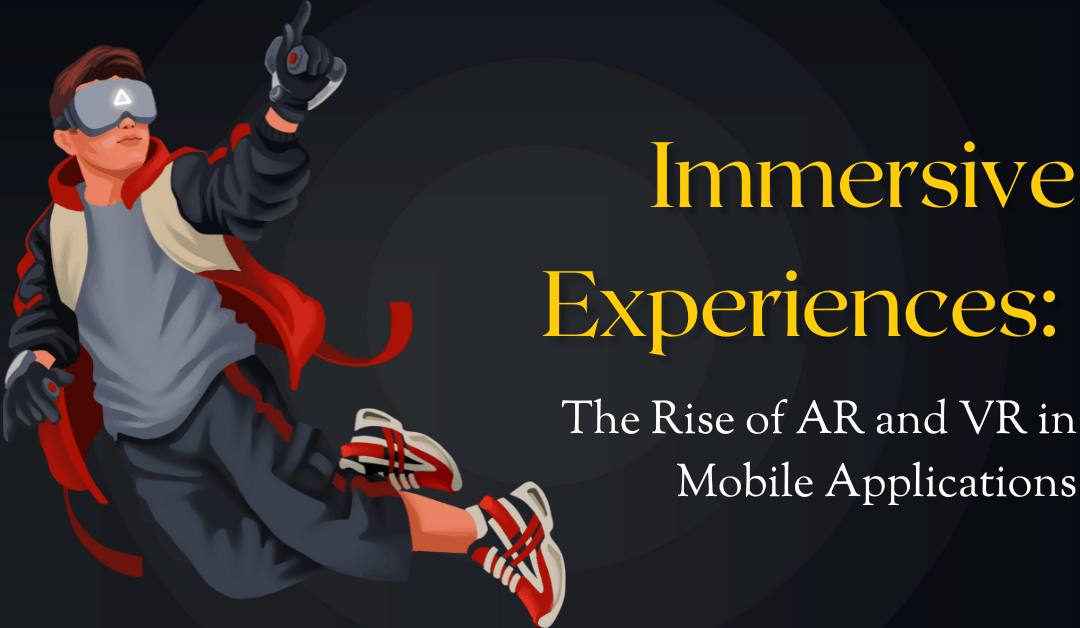Immersive Experiences: The Rise of AR and VR in Mobile Applications
Your smartphone is no longer just a screen; it’s a window into new realities. The line between the digital and physical worlds is blurring, thanks to the rapid rise of AR and VR in mobile applications. These technologies are fundamentally shifting how we shop, learn, play, and interact with the world around us, moving us from passive swiping to active, immersive participation.
This article explores how augmented and virtual reality are transforming the mobile landscape, the real-world examples you can use today, and what’s coming next in this exciting field.
Quick Overview: The Impact of Mobile AR and VR
- What is it? Augmented Reality (AR) overlays digital information onto your real-world view (think Pokémon Go or Snapchat filters). Virtual Reality (VR) creates a fully immersive, 360-degree digital environment (often requiring a headset but increasingly accessible on mobile).
- Why does it matter? It changes the user experience from transactional (tapping buttons) to experiential (interacting with a 3D space).
- Where is it used? Retail (virtual try-ons), gaming (immersive worlds), education (interactive models), real estate (virtual tours), and navigation (Google Maps AR).
How AR and VR in Mobile Applications Are Changing Industries
These technologies are far from gimmicks. They are solving real problems and creating powerful new opportunities for customer engagement.
1. Retail and E-commerce: “Try Before You Buy”
The biggest challenge for online shopping has always been the inability to see or touch a product. AR and VR in mobile applications are erasing this barrier.
- Virtual Try-Ons: Apps from retailers like IKEA (IKEA Place) let you place true-to-scale 3D models of furniture in your living room. Similarly, brands like Adidas and YouCam Makeup let you “try on” shoes or cosmetics using your phone’s camera.
- Increased Conversions: By giving customers confidence in their purchase, AR-powered retail apps significantly reduce return rates and boost sales.
2. Gaming and Entertainment: A New Level of Play
Gaming has been the most prominent driver for this technology. Mobile AR and VR create experiences that are impossible on a traditional 2D screen.
- Augmented Reality: The most famous example is Pokémon Go, which turned the entire world into a game map.
- Virtual Reality: Mobile VR headsets powered by smartphones (like the older Samsung Gear VR) or standalone devices (like the Meta Quest) transport players to new worlds, making them the protagonist in their own story.
3. Education and Training: Learning by Doing
Imagine studying human anatomy by holding a beating 3D heart in your hand or learning history by walking through ancient Rome.
- Interactive Learning: Educational apps use AR to bring textbook diagrams to life. Students can explore complex machinery, animal biology, or solar systems from all angles.
- Safe Training: VR applications allow medical students to practice complex surgeries or engineers to train on heavy machinery in a risk-free, simulated environment.
4. Navigation and Travel: Finding Your Way
Even a daily task like navigation is being transformed. Google Maps now features an AR “Live View” that overlays walking directions and street names onto your camera’s view, making it almost impossible to get lost.
The Key Difference: AR vs. VR on Mobile
While often grouped, they serve different purposes.
|
Feature |
Augmented Reality (AR) |
Virtual Reality (VR) |
|
Core Concept |
Overlays digital elements onto the real world. |
Replaces the real world with a fully digital one. |
|
Hardware |
Your smartphone’s camera (e.g., Snapchat). |
A headset (e.g., Meta Quest). |
|
User State |
Aware of and interacting with their surroundings. |
Fully immersed and isolated from surroundings. |
|
Example |
Seeing a new sofa in your living room. |
“Standing” inside a virtual showroom. |
The Future: What’s Next for AR and VR in Mobile Applications?
The growth of AR and VR in Mobile Applications is just getting started. Several key trends are accelerating their adoption:
- WebAR: This allows you to experience AR directly in your mobile browser without downloading an app, making it faster and more accessible.
- 5G Integration: Faster speeds and lower latency from 5G will enable more complex, high-fidelity, and multiplayer AR/VR experiences on the go.
- AI and Spatial Computing: Artificial intelligence is making AR “smarter.” It can understand your environment, recognize objects, and provide context-aware information, blending the digital and physical worlds seamlessly.
Frequently Asked Questions (FAQ)
Q: What is the main benefit of AR in mobile apps?
A: The main benefit is enhanced user engagement. AR allows users to visualize products in their own space (like furniture or clothes), interact with information in a new way (like AR maps), and play games that blend with reality, leading to higher satisfaction and conversion rates.
Q: Do I need a special headset for VR on my phone?
A: While basic VR experiences can be viewed by moving your phone (like a 360-degree YouTube video), a true immersive experience requires a headset. These range from simple cardboard viewers to standalone wireless headsets like the Meta Quest 3, which don’t require a phone at all.
Q: What’s the difference between ARKit and ARCore?
A: They are the software development kits (SDKs) that developers use to build AR experiences. ARKit is Apple’s platform for iOS (iPhone/iPad), and ARCore is Google’s platform for Android devices.
Q: Is mobile AR just for games and shopping?
A: Not at all. While gaming and retail are popular, AR is being used heavily in education (interactive textbooks), healthcare (visualizing veins for nurses), industrial settings (repair instructions), and navigation (Google Maps Live View).
Conclusion
The era of the flat, 2D app is evolving. AR and VR in mobile applications are pioneering a new, immersive internet where users are no longer just observers but active participants. From trying on sneakers virtually to navigating a new city with digital arrows at your feet, this technology is already enhancing our daily lives. As mobile devices become more powerful and 5G networks expand, these immersive experiences will become the new standard for how we connect, shop, learn, and play.

